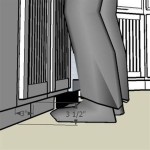Restaining Kitchen Cabinets Without Sanding: Essential Aspects to Consider
Restaining kitchen cabinets without sanding is a viable approach for updating your kitchen's aesthetics without the laborious task of stripping the existing finish. Achieving a successful refinishing project requires attention to specific aspects, ensuring both a visually appealing and durable outcome.
To delve deeper into the essential elements of restaining kitchen cabinets without sanding, let's examine each aspect in detail:
1. Surface Preparation
Meticulous surface preparation is paramount. Thoroughly clean the cabinets using a degreasing cleaner to remove dirt, grease, and other contaminants. Address any imperfections, such as dents or scratches, with appropriate fillers or putty. Sanding may be necessary in localized areas for smoothing out repairs.
2. Stain Selection
Choosing the right stain is crucial. Consider the existing cabinet color, desired finish, and overall kitchen aesthetic. For a subtle change, opt for a stain similar to the current shade. For a more dramatic transformation, select a contrasting color. Test the stain on an inconspicuous area to assess the final result before applying it to the entire surface.
3. Application Technique
Apply the stain evenly with a brush, roller, or sponge. Use long, smooth strokes and avoid overworking the finish. Allow the stain to penetrate for the recommended time indicated on the product label. Wipe off excess stain with a clean cloth to prevent blotching or streaks.
4. Grain Direction
Pay attention to the grain direction of the wood. Apply the stain in the same direction as the grain to enhance its natural beauty and avoid creating an uneven appearance. Use a light touch and avoid applying too much pressure, as this can obscure the wood's texture.
5. Multiple Coats
Applying multiple thin coats rather than a single thick coat yields a more even and durable finish. Allow each coat to dry completely before applying the next. The number of coats required depends on the desired color intensity and the absorbency of the wood.
6. Topcoat Protection
To safeguard the stained surface and enhance its durability, apply a protective topcoat. Choose a polyurethane or water-based finish that is compatible with the stain and provides the desired level of sheen. Apply the topcoat in thin, even coats, allowing each coat to dry thoroughly before applying the next.
7. Maintenance and Care
Regular maintenance will preserve the beauty and longevity of your refinished cabinets. Clean them regularly with a mild detergent and avoid using harsh chemicals or abrasive cleaners. Touch up any scratches or wear spots as needed to maintain their pristine appearance.
By adhering to these essential aspects, you can successfully restain your kitchen cabinets without sanding, achieving a refreshed and rejuvenated kitchen space.

Staining Your Wood Cabinets Darker Young House Love

Gel Stain Kitchen Cabinets Without Sanding Fast Easy Diy

How To Refinish Kitchen Cabinets Without Stripping Ron Hazelton

Update Kitchen Cabinets No Sanding

Cabinet Refinishing An 8 Step Guide For Pro Painters Ppc

The Fast Affordable Way To Upgrade Your Kitchen Cabinet Refinishing

How To Re Worn Kitchen Cabinets Without A Complete Overhaul The Seattle Times

Refinishing Kitchen Cabinets Modern Refacing Made Easy Wisewood

What We Learned From A Forever Project To Refinish Kitchen Cabinets The Pecks Oregonlive Com

How To Make Rustic Kitchen Cabinets By Refinishing Them The Best Stain Color Amanda Katherine
Related Posts








